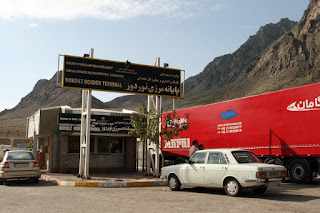Iran ایران : Tehran (Iranian capital), Tabriz (biggest city in NW Iran), Jolfa (Iranian city neighboring Azerbaijan)
Armenia Հայաստան : Goris, Yerevan (Armenian capital)
Georgia საქართველო : Tbilisi (Georgian capital), Mtskheta, Stepantsminda, Batumi, back to Tbilisi
The flight:
I took the Air Asia X flight from Kuala Lumpur to Tehran. In the airplane, i only came across 3 non-Iranians, or 3 person of non middle-eastern descent. I believed that 3 person were tourists, but did not get the chance to speak to them. An Iranian man was sitting next to me, he spoke in broken English, claiming he is a economics PhD student at a University around Malaysia.
 |
| Queuing at the Iman Khomeini Airport |
Iran
The Islamic Republic of Iran is a country in Western Asia.
Iman Khomeini Airport:
Upon arriving at Iman Khomeini Airport at Tehran, at the immigration booth, the Iranian official, who is a man with moustache, browsed through my passport. Then he said, "ah, Malaysian passport". He gave the passport to another guy, that guy led me to a room. A machine is on the table; in the dimly lit room, he took my thumb print, and he said:
"Welcome to Iran"
Tehran:
So i was in Tehran, the biggest city in Iran with a population of 12 million people.
I went to a grocery store to get some food. I don't know why the guy was happy.
In downtown Tehran, i took a picture in front of the Milad Tower. It is the tallest tower in Iran.
The next day, i tried to look for the old American Embassy in Tehran. I saw this sign "Down with USA".
I turned to the other corner, and saw the National Museum of Iran instead.
I kept on walking, and entered a park. Later, i found out it is called "Laleh Park". It is a peaceful and neatly decorated park. Without having much to do, i left the park.
I went to the Grand Bazaar of Tehran.
There were too many people in the grand bazaar. I took a car, and went to a gas station to pump gasoline. I had to stop the car as there were many cars waiting for their turns. In the picture above, this guy took his time to clean the car window.
The car moved on. A traffic police holding a stop sign was walking along the busy road.
A group of Iranian tourists asked me to take a picture for them.
In the evening, the sun was setting. I went back to the Tehran city center.
I went to the landmark of Tehran, the Azadi Tower برج آزادی. It was built in 1971 to commemorate the 2500 years of the Persian Empire. Azadi is Persian word, it means freedom.
At night, i went to a mosque, the Imāmzādeh Sāleh mosque. It is located at Tajrish Square in northern Tehran, at 1612 meters above see level.
The next day morning, i went to the Military Museum of Tehran.
At the bus station, it was quiet in the morning.
The bus to Tabriz was waiting.
The highway to Tabriz.
Tabriz:
Tabriz is one of the historical capitals of Iran and the capital of East Azerbaijan Province.
The population is around 1.4 million people.
After 6-7 hours, i arrived at Tabriz.
The Blue Mosque of Tabriz, it is a UNESCO world heritage. It was built in the 15th century.
The hostel i stayed for the night.
The next day, i took a cab and went out of the city. The pictures shows some gray-looking apartments in the desert.
The magic chimney of Kandovan village.
I was at the Kandovan village.
An overall view of the Kandovan village, the young girl in red was trying to communicate to me in Persian. There i wish i could speak Persian.
I took their picture again at Kandovan village.
Outside the Tabriz bazaar, another UNESCO world heritage site.
Jolfa:
Jolfa is located to the north of Tabriz. It borders the country of Azerbaijan.
At Jolfa, the border town, notice that the sign post is written in Persian and Russian languages.
At the immigration border to Azerbaijan, i did not go to Azerbaijan for this trip. For some reasons, Azerbaijan and Armenia have territory disputes and war. Their borders are closed. They are still technically at war.
The next day, i went to visit the Saint Stepanos church, it is an Armenian monastery built in the 9th century. It is part of the UNESCO world heritage, called the Armenian Monastic Ensemble in Iran.
inside the church, the main door is dated from 9th century.
outside the church, i still wore the same shirt from the 1st day.
the Aras river, separating Iran from Azerbaijan.
Now this is the Iran Armenian border, the mountain in the background belongs to Armenia. You can see the Iranian watch tower looking at it.
At the border terminal before going to Armenia.
Crossing the Iranian-Armenian border: The border is separated by Aras river, with a bridge built over it. Photo is prohibited at this border checkpoint. I took this pic somewhat. The picture shows the last Iranian guard house after exiting the immigration building, walking past the guard house, one Iranian soldier sitting on one side of the bridge. I kept walking past the soldier and crossing the bridge, an Armenian soldier asked to see my passport, then he said "welcome to Armenia". I walked further to the immigration compound of Armenia.
























chimney.jpg)














